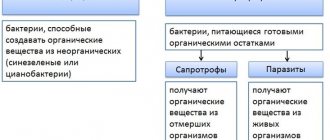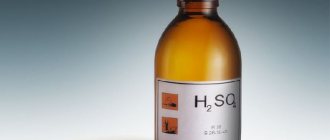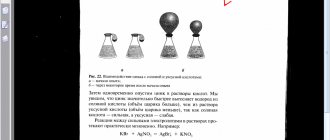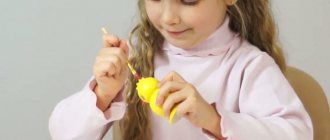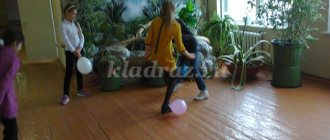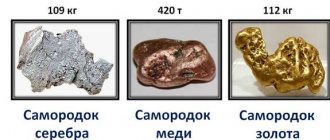Chemistry 9th grade - lesson development
Lesson 1. Topic: Periodic law and D. I. Mendeleev’s Periodic Table of Elements. Structure of matter (REPEAT)
Lesson 2. Topic: Chemical bond. Structure of matter. Crystal lattices
Lesson 3. Topic: Main classes of inorganic compounds: acids, oxides, bases, salts. Types of chemical reactions
Lesson 4. Topic: Electrolytes and non-electrolytes. Electrolytic dissociation of substances in aqueous solutions
Lesson 5. Topic: Electrolytic dissociation of acids, alkalis and salts
Lesson 6. Topic: Weak and strong electrolytes. Degree of dissociation
Lesson 7. Topic: Ion exchange reactions and conditions for their occurrence
Lesson 8. Topic: Ion exchange reactions and conditions for their occurrence
Lesson 9. Topic: Redox reactions. Oxidation and reduction
Lesson 10. Topic: Oxidation-reduction reactions. Oxidation and reduction
Lesson 11. Topic: Hydrolysis of salts
Lesson 12. Topic: Practical work No. 1. Solving experimental problems on the topic “Electrolytic dissociation”
Lesson 13. Topic: Test No. 1 on the topic “Electrolytic dissociation”
Lesson 14. Topic: The position of oxygen and sulfur in the periodic table of chemical elements, the structure of their atoms. Ozone is an allotropic modification of oxygen
Lesson 15. Topic: Sulfur. Allotropy of sulfur. Physical and chemical properties of sulfur. Application of sulfur
Lesson 16. Topic: Hydrogen sulfide. Sulfides
Lesson 17. Topic: Sulfur dioxide. Sulfurous acid and its salts
Lesson 18. Topic: Sulfur (VI) oxide. Sulfuric acid and its salts
Lesson 19. Topic: Oxidizing properties of concentrated sulfuric acid
Lesson 20. Topic: Practical work No. 2. Solving experimental problems on the topic “Oxygen subgroup”
Lesson 21. Topic: The concept of the rate of a chemical reaction. Catalysts. Chemical equilibrium
Lesson 22. Topic: Calculation using chemical equations of reactions of mass, amount of substance or volume from a known mass, amount of substance or volume of one of the substances entering or resulting in the reaction
Lesson 23. Topic: The position of nitrogen and phosphorus in the periodic table of chemical elements, the structure of their atoms. Nitrogen, physical and chemical properties, preparation and application
Lesson 24. Topic: Ammonia. Physical and chemical properties of ammonia, production, application
Lesson 25. Topic: Practical work No. 3. Obtaining ammonia and studying its properties
Lesson 26. Topic: Ammonium salts
Lesson 27. Topic: Nitric acid. Molecule structure and preparation
Lesson 28. Topic: Oxidative properties of nitric acid
Lesson 29. Topic: Salts of nitric acid
Lesson 30. Topic: Phosphorus. Allotropy and properties
Lesson 31. Topic: Phosphorus(V) oxide. Orthophosphoric acid and its salts. Mineral fertilizers
Lesson 32. Topic: Practical work No. 4 on the topic “Determination of mineral fertilizers”
Lesson 33. Topic: The position of carbon and silicon in the periodic table of chemical elements, the structure of their atoms. Carbon, allotropic modifications
Lesson 34. Topic: Chemical properties of carbon. Adsorption
Lesson 35. Topic: Carbon monoxide, properties, physiological effect on the body
Lesson 36. Topic: Carbon dioxide, carbonic acid and its salts
Lesson 37. Topic: Practical work No. 5. Obtaining carbon monoxide (IV) and studying its properties. Carbonate recognition
Lesson 38. Topic: Silicon and its compounds. Glass. Cement
Lesson 39. Topic: Test No. 2 on the topic “Oxygen and sulfur. Nitrogen and phosphorus. Carbon and silicon"
Lesson 40. Topic: The position of metals in the periodic table of chemical elements by D. I. Mendeleev. Metal connection
Lesson 41. Topic: Chemical properties of metals. Metals voltage range
Lesson 42. Topic: Alkali metals. Occurrence in nature, properties and applications
Lesson 43. Topic: Calcium and its compounds
Lesson 44. Topic: Water hardness and ways to eliminate it
Lesson 45. Topic: Aluminum. The position of aluminum in the periodic table and the structure of its atom. Being in nature. Physical and chemical properties of aluminum
Lesson 46. Topic: Generalization of knowledge on the topic “Elements IA-IIIA of the PSHE group”
Lesson 47. Topic: Iron. The position of iron in the periodic table and the structure of its atom. Being in nature. Physical and chemical properties of iron
Lesson 48. Topic: Oxides, hydroxides and salts of iron(II) and iron(III)
Lesson 49. Topic: The concept of metallurgy. Methods for obtaining metals. Alloys (steel, cast iron, duralumin, bronze). The problem of waste-free production in metallurgy and environmental protection
Lesson 50. Topic: Practical work No. 6. Solving experimental problems on the topic “Metals and their compounds”
Lesson 51. Topic: Test No. 3 on the topic “Metals”
Lesson 52. Topic: Initial information about the structure of organic substances. Basic principles of the theory of the structure of organic compounds by A. M. Butlerov
Lesson 53. Topic: Isomerism. Simplified classification of organic compounds
Lesson 54. Topic: Saturated hydrocarbons. Methane, ethane. Physical and chemical properties. Application
Lesson 55. Topic: Unsaturated hydrocarbons. Ethylene. Physical and chemical properties. Application
Lesson 56. Topic: Acetylene. Diene hydrocarbons. The concept of cyclic hydrocarbons (cycloalkanes, benzene)
Lesson 57. Topic: Natural sources of hydrocarbons. Oil and natural gas, their application. Protection of atmospheric air from pollution
Lesson 58. Topic: Monohydric alcohols. Methanol. Ethanol. Physical properties. Physiological effect of alcohols on the body. Application
Lesson 59. Topic: Polyhydric alcohols. Ethylene glycol. Glycerol. Application
Lesson 60. Topic: Formic and acetic acids. Physical properties. Application
Lesson 61. Topic: Fats. Biological role of fats
Lesson 62. Topic: Glucose and sucrose are the most important representatives of carbohydrates. Starch and cellulose are natural polymers
Lesson 63. Topic: Proteins - biopolymers
Lesson 64. Topic: Polymers. Polyethylene, polypropylene, polyvinyl chloride
Lesson 65. Topic: Test No. 4 “Organic compounds”
Chemistry lesson. 9th grade. Topic: “Introduction to organic chemistry”
Lesson topic: “Introduction to organic chemistry”
Subject
: Chemistry Grade: 9
Lesson goal
: Creating conditions for “immersion” in organic chemistry.
Lesson objectives: Educational
.
Study the chemical composition of organic substances, identify the difference between organic substances and inorganic ones, determine the subject of study of organic chemistry, the goals and objectives of organic chemistry. Developmental.
Develop the ability to work with primary sources and additional information: highlight the main thing and draw up a supporting summary.
Develop skills in conducting chemical experiments, observing safety rules. Develop the ability to observe, compare, and draw conclusions. Develop memory, logical thinking, attention. Educational
.
To cultivate neatness, hard work, patriotic, aesthetic and moral qualities. Lesson type:
Lesson on learning new material.
Lesson technical support:
Multimedia projector, computer, equipment and reagents for conducting a chemical experiment.
Expected result:
- define concepts: the subject of organic chemistry, organic substances - compare organic and inorganic substances - know the goals and objectives of organic chemistry, - name the names of organic scientists - be able to identify organic substances in plant objects.
During the classes
Org moment.
Good morning, guys. Good morning, dear guests! Let's smile at each other! And let’s start our lesson in a good mood. I hope the lesson will be productive for you, and most importantly, useful!
I want to start the lesson with the words of M. Gorky: “First of all and most carefully, study chemistry. This is an amazing science, you know... Its keen, bold gaze penetrates into the fiery mass of the sun and into the darkness of the earth’s crust, into the invisible particles of your heart, and into the secrets of the structure of a stone, and into the silent life of a tree. She looks everywhere and, discovering harmony everywhere, persistently seeks the beginning of life..."
I.Challenge and goal setting stage
Today you will work in groups and pairs. And pay attention, we have 11th graders sitting in the third row. Why are they here? Yes, to help you study chemistry. Well, we will find out what section they are studying as the lesson progresses.
Open your notebooks and write down the number.
Guys, let’s make a cluster - write the words “chemicals” in the center of the notebook. We work in pairs. Each pair makes up its own cluster.
The cluster is prepared on the board
slide1
What associations do you have with these words? Label examples of chemicals that you are familiar with from everyday life around the words “chemicals.”
Slide 2
For two years, you and I studied one section of chemistry called “inorganic chemistry.” Look at the diagram and list the substances that are classified as inorganic substances.
Called inorganic substances (water, oxygen, etc....)
What substances have we not yet studied, name them? Sugar, starch, fats, proteins...
Here are two collections in front of you, look carefully, how are they similar and how are they different? What groups can you divide these collections into?
What branch of chemistry do you think studies these substances? organic chemistry.
Let's remember what we studied in the inorganic chemistry section - 9th grade.
What classes of substances exist in inorganic chemistry? Oxides, acids, salts, bases
What classes does the organic chemistry section study? - Grade 11
From today's lesson we begin to study the section - organic substances and the topic of our lesson (formulate): "The subject of organic chemistry."
Let's return to the cluster.
These organic substances are familiar to you. What does it contain ?
?
Do we know? – 9th grade
structure do they have?
?
Do we know? — 9th grade
Distinctive features
How do they differ from inorganic substances?
Which substances are more numerous - organic or inorganic? ( reasons for diversity
) – 9th
grade
Look at page 214. Which substances are there more?
II . Content comprehension stage
Look how many questions we have! We will look for answers to the questions posed in class!
I suggest using the help of 11th grade.
Working with 11 Klaas
Group 1.
How were organic substances obtained in ancient times? Why are these substances called organic?
Answer:
All organic substances were obtained exclusively from waste products of plant and animal organisms or as a result of their processing. This is where the name “organic matter” comes from.
Group 2.
What does organic chemistry study?
Answer:
The branch of chemistry that studies organic substances came to be called organic chemistry.
Group 3.
What chemical element is necessarily included in the composition of organic substances?
Answer:
All organic substances contain the chemical element carbon.
Question 4.
What other definition of organic chemistry can be given?
ANSWER:
Organic chemistry is the chemistry of carbon compounds
(write the wording in your notebook).
Question 5. Besides carbon, what chemical element is included in organic matter?
ANSWER:
In addition to carbon, all organic substances contain the chemical element hydrogen.
O, S, N and other elements may also be included (write the signs of chemical elements on the board).
Question 6. What chemical property can be common to organic substances?
ANSWER:
All organic substances burn.
What substances are formed when organic substances burn? carbon dioxide and water (writing in a notebook with words and reaction ) conclusion about what was said
Guys, another interesting property of organic substances is the ability to char and decompose when heated. Let's take examples from life. What happens to foods containing starch and protein? Coal is formed.
If you overcook potatoes, pancakes, pancakes, bread, the starch contained in the potatoes and flour becomes charred. When eggs or meat burn, the protein contained in these foods is charred.
Guys, what happens if you put table salt and sugar on a hot frying pan?
Let's conduct an experiment (instructions)
Why do you think table salt and sugar behave differently when heated?
These substances have different crystal lattices.
What is the crystal lattice of table salt and sugar? In table salt, NaCl is an ionic crystal lattice, and in sugar, C 12 H 22 O 11 is a molecular lattice.
What type of chemical bond is characteristic of organic substances. Covalent polar chemical bond
) conclusion about what has been said
Guys, let's write down the characteristics of organic substances:
1) contain carbon; 2) burn and (or) decompose to form carbon-containing products; 3) covalent chemical bond; 4) molecular crystal lattice
| Reagents | Description or outline of the experience | Equipment |
| Copper (II) oxide CuO, granulated sugar, lime water | Lime water A mixture of sugar and copper (II) oxide | 2 test tubes, a stopper with a gas outlet tube, a tripod, an alcohol lamp, matches, asbestos mesh, dry fuel. |
| Precautionary measures | Progress of the experiment | Notes |
| First, heat the entire test tube, and then its end. At the end of the experiment, remove the gas outlet tube from the limewater, then turn off the alcohol lamp. | Pour 0.2 g of granulated sugar and 2-3 times more copper (II) oxide into a dry test tube, mix everything thoroughly and start heating. Record your observations. 1. What gas caused the limewater to become cloudy? Write the reaction equation. 2. What substance was formed on the cold walls inside the test tube? 3. What substance was formed from copper (II) oxide? Write an equation for the reaction between copper(II) oxide and carbon. Draw a conclusion about whether granulated sugar belongs to organic or inorganic compounds. ) conclusion about what was said | Stop the experiment as soon as the lime water becomes cloudy. |
Let's remember the structure of the carbon atom.
How many energy levels does it have, what group is it in? How many electrons does it have in its outer layer? In the excited state, the valency of carbon is 4. And in all organic compounds, the carbon atom is always tetravalent.
The simplest formula in organic chemistry, CH4, is methane. We use structural formulas. (Create a structural formula - grade 11)
C lied3
Valency is indicated by dashes: one dash corresponds to the unit of valence of an atom of a chemical element.
What organic substances studied in the lesson can be added to the “cluster” we have compiled? oil, candle, propane, glucose, butane, dichloromethane, acetic acid, acetylene, ethane, etc.
What is the valence of carbon in organic compounds? In organic compounds, carbon is always tetravalent
What chemical property is common to organic compounds? Many organic substances burn or decompose when heated without the introduction of air.
What is the importance of organic matter in society? These are food, clothing, shoes, synthetic materials, polymers, energy carriers, medicines, synthetic detergents, various paints, varnishes, dyes, toothpaste, shampoos, etc.
What effect do organic substances have on the human body? (Roxana, Rita)
III . Reflection
Guys, today we learned that organic chemistry is studied. What chemicals are called organic. The concept of valency of chemical elements was revealed. We examined the importance of organic substances and showed, with the help of additional literature, the negative impact of some of them on the environment.
Have we answered the questions we asked at the beginning of the lesson?
Guys, you have tests on the topic you studied on your table. Let's test your knowledge (2-3 min) Choose one correct answer. C lead 4
1. What does organic chemistry study?
A) All compounds formed in living organisms.
B) Compounds of carbon with hydrogen.
B) Carbon compounds, with the exception of oxides, carbides, salts.
2. Which compound is classified as organic?
A) Acetic acid.
B) Baking soda.
B) Table salt.
3. By 2005, the number of known organic compounds is……
A) About 1 million
B) About 15 million
B) About 2 million
4. What are the names of compounds consisting only of hydrogen and carbon?
A) Organic substances.
B) Minerals.
B) Hydrocarbons.
5. The mass fraction of carbon in CH4 methane is equal to
A) 75%
B) 80%
B) 25%
C lead 5
IV . Summarizing
Guys, on everyone’s desk there is a table “Reflection on the student’s activities in the lesson.”
I ask you to fill out the table and give it to me.
V. _
Homework C slide 6
Study § 48+ notes, *task No. 1,2 p. 216 (for everyone), *task No. 36 p. 216 for in-depth study.
Now imagine what will happen if organic matter disappears.
There will be no more wooden objects, no more ballpoint pens, no book bags, no more books and notebooks made from organic matter - cellulose. There will be no linoleum in the classroom; only metal legs will remain from the desks. Cars will not drive on the street - there is no gasoline, and only metal parts will remain from the cars themselves. Computer and TV cases will disappear. Pharmacies will be out of most medications, and there will be nothing to eat (all food also consists of organic compounds). There will be nothing to wash your hands with and nothing to put on yourself, because soap and cotton, wool, synthetic fibers, leather and leather substitutes, fabric dyes are all derivatives of hydrocarbons. And there will be no one to look at this world - all that will be left of us is salt water and a skeleton, because the organisms of all living beings consist of organic compounds.
Now you understand the role of organic compounds in nature and our lives
C slide 6
this is interesting
While you are reading this article, your eyes are using
organic compound
- retinal
, which converts light energy into nerve impulses.
While you sit in a comfortable position, the back muscles
maintain correct posture by
chemically breaking down glucose
to release the required energy.
As you understand, the gaps between nerve cells are also filled with organic substances - mediators
(or neurotransmitters), which help all neurons become one. And this well-coordinated system works without the participation of your consciousness! Only organic chemists understand as deeply as biologists how intricately man is created, how logically the internal systems of organs and their life cycle are arranged. It follows that the study of organic chemistry is the basis for understanding our life! And high-quality research is the way to the future, because new drugs are created primarily in chemical laboratories.
Self-analysis of the lesson
teacher of chemistry and biology Utkina A.I.
The lesson was held in the 9th grade of the Proletarskaya Secondary School.
Subject
lesson "Introduction to organic chemistry
"
. The class size is standard, average in its abilities, six students are assigned to the 7th type of education. Therefore, I set the main developmental goal to enable children to be active participants in the educational process, by including them in solving educational problem situations to develop their logical thinking and maintaining attention through changing educational activities and reflecting on individual stages of the lesson.
The lesson "Introduction to Organic Chemistry" is the first lesson in the transition to the study of organic chemistry and is intended to give a general overview and highlight the main emphasis and concepts. This is especially important since we are starting a new section in chemistry, “Organic Compounds,” for which 10 hours are allotted.
Lesson type
– a lesson in learning new material
Place of the lesson in the curriculum
– a lesson in introducing new material.
Level of lesson delivery: predicting ways to move students to the result specified by the learning goals based on feedback and overcoming possible difficulties in their work.
the main objective
(for students) – in the process of practical activities, based on an analysis of the composition of substances, divide substances into organic and inorganic and confirm the prediction experimentally. The main task associated with the formation of activity experience is the enrichment of the student’s personal experience through an educational experiment and the establishment by logical means of the properties of organic substances.
The topic and content of the lesson predetermined the formulation of educational tasks:
- To cultivate neatness, hard work, patriotic, aesthetic and moral qualities.
- Continue the formation of tolerance through the implementation of certain types of collective work: updating knowledge, practical assignments, laboratory experience.
These tasks were solved in combination at all stages of the lesson. All stages are logically interconnected:
The organizational moment set the students up to achieve the goal: the goal of the lesson was communicated, the predicted result was announced, and motivation to realize the goal. All this made it possible to include students in the course of the lesson.
At the second stage of the lesson, updating knowledge and analyzing information, a differentiated approach was used: 11th grade students completed the task of the interaction of sugar with copper oxide and lime water. A task to systematize and integrate knowledge (work - searching and deploying information) and finding a creative solution (task to compile reaction equations). Students of intermediate level of knowledge completed analytical tasks on the combustion of inorganic and organic substances. During my work, I carried out the necessary consultations in order to create a “success situation”.
I preferred to teach most of the educational material deductively. To do this, students were asked to answer questions, the answers to which previously acquired knowledge were voiced, and at the same time we began to study new material. This allowed me to use such important principles of didactics as scientific approach and accessibility.
Interdisciplinary connections have been implemented through the use of materials from biology and technology “This is interesting” during the presentation. Observing the principle of systematicity, we walked from the known to the unknown (the students knew the substances, but could not explain them), from simple to complex. It was impossible to do without a demonstration experiment, since it contributed to the development of skills in conducting a chemical experiment.
To check the level of knowledge acquisition, students completed a test control.
The following teaching methods were used during the work:
- Verbal (the role of organic substances for humans, etc.);
- Visual (demonstration of slides, test);
- Problem-search (individual and group tasks to predict the properties of substances)
- Heuristic
- Research (experiment);
- Laboratory method.
The combination of these methods in the lesson showed high efficiency. Optimal performance of students in the lesson was achieved by alternating types of learning activities at different stages of the lesson and in a calm, friendly environment. All this ensured that students were not overloaded.
Special attention was paid to homework instruction, as it requires an understanding of the topic as a whole.
The final stage was the assessment of the lesson results, summing up and commenting on the students’ activities.
The purpose of the lesson is fulfilled, the tasks are realized.
